 W
WJewellery or jewelry consists of decorative items worn for personal adornment, such as brooches, rings, necklaces, earrings, pendants, bracelets, and cufflinks. Jewellery may be attached to the body or the clothes. From a western perspective, the term is restricted to durable ornaments, excluding flowers for example. For many centuries metal such as gold used in different carats from 21, 18, 12, 9 or even lower, often combined with gemstones, has been the normal material for jewellery, but other materials such as shells and other plant materials may be used.
 W
WAnglo-Saxon brooches are a large group of decorative brooches found in England from the fifth to the eleventh centuries. In the early Anglo-Saxon era, there were two main categories of brooch: the long (bow) brooch and the circular (disc) brooch. The long brooch category includes cruciform, square-headed, radiate-headed, and small-long brooch brooches. The long brooches went out of fashion by the end of the sixth century.
 W
WArchitectonic jewellery is a subset of Constructivist studio jewellery that makes use of architectural forms and ideas in the much smaller-scale format of jewellery. Some of the defining elements of architectonic jewellery are linearity, inclusion of geometric elements, undisguised structural elements, and use of varying depth to convey a sense of design in three dimensions rather than only two. Certain architectonic pieces include moving parts, which enables "extending or reconfiguring" the pieces by the wearer. Architectonic jewellery often incorporates materials more typically used in engineering such as stainless steel and niobium, reinforcing the association with architecture.
 W
WAn arm ring, also known as an armlet or an armband, is a band of metal, usually a precious metal, worn as jewelry or an ornament around the biceps of the upper arm. The arm ring is similar to a bracelet or bangle, though it must be shaped and sized to fit snugly to the upper arm.
 W
WBangles are traditionally rigid bracelets which are usually made of metal, wood, glass or plastic. These ornaments are worn mostly by women from Asia and Africa. It is common to see a new bride wearing glass bangles at her wedding. Bangles may also be worn by young girls and bangles made of gold or silver are preferred for toddlers.
 W
WBeetlewing, or beetlewing art, is an ancient craft technique using iridescent beetle wings practiced traditionally in Thailand, Myanmar, India, China and Japan.
 W
WBerlin iron jewellery refers to articles of cast-iron jewellery that were made during the early 19th century in Germany.
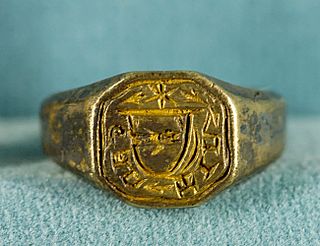 W
WThe bezel is a wider, and usually thicker, section of the hoop of a ring, which may contain a flat surface, or a gem. The ring is normally worn to display the bezel on the upper or outer side of the finger. The word may also refer to a bezel setting for a stone, which is a general term for a setting holding the stone in place using a raised surrounding for the stone with a lip encircling and overlapping the edges of the stone, thus holding it in place. Modern bezel settings typically use a band of metal containing a groove and a flange to hold a watch crystal or gemstone in its setting. This was the earliest method of setting gemstones into jewelry. In historic examples, such rings were often made by leaving a hole or slot in the ring with a thin lip which was bent over once the stone was inserted, holding it in place.
 W
WA bijou from the French bijou is an intricate jewellery piece incorporated into clothing, or worn by itself on the body.
 W
WBling-bling, often shortened to just bling, is "flashy jewelry worn especially as an indication of wealth or status; broadly: expensive and ostentatious possessions" such as grills and designer bags. The term arose as localized slang, but grew into a cultural mainstay. Prominent examples of bling-bling include a large cross necklace or Jesus piece.
 W
WBreast milk jewelry or Breast milk jewellery is jewellery made from pumped or expressed mother's breast milk as a keepsake often worn by the mother. Breast milk keepsakes come in various jewelry types such as rings, lockets, pendants and popular European style beads. Some pendants may be bezel set, locket set, made from only resin, or filled. Filled styles use a preserved breast milk and resin mix to fill holes or openings in jewelry pieces, usually Sterling Silver. Generally, the filled shapes are trees, leaves, or hearts representing love and life.
 W
WA cap hook is a decorative hat ornament fashionable from the late Middle Ages through the Tudor period, used to pin up or decorate men's hat brims. Cap hooks were made of gold, silver, or silver-gilt base metal, and might be decorated with jewels or enamelling.
 W
WCatacomb saints were the bodies of ancient Christians that were carefully exhumed from the catacombs of Rome and sent abroad to serve as relics of certain saints from the 16th century to the 19th century. They were typically lavishly decorated with gold and precious stones.
 W
WA chain is a serial assembly of connected pieces, called links, typically made of metal, with an overall character similar to that of a rope in that it is flexible and curved in compression but linear, rigid, and load-bearing in tension. A chain may consist of two or more links. Chains can be classified by their design, which can be dictated by their use:Those designed for lifting, such as when used with a hoist; for pulling; or for securing, such as with a bicycle lock, have links that are torus shaped, which make the chain flexible in two dimensions. Small chains serving as jewellery are a mostly decorative analogue of such types. Those designed for transferring power in machines have links designed to mesh with the teeth of the sprockets of the machine, and are flexible in only one dimension. They are known as roller chains, though there are also non-roller chains such as block chain.
 W
WCut steel jewellery is a form of jewellery composed of steel that was popular between the 18th century and the end of the 1930s.
 W
WThe Dacian bracelets are bracelets associated with the ancient people known as the Dacians, a distinct branch of the Thracians. These bracelets were used as ornaments, currency, high rank insignia and votive offerings Their ornamentations consist of many elaborate regionally distinct styles. Bracelets of various types were worn by Dacians, but the most characteristic piece of their jewelry was the large multi-spiral bracelets; engraved with palmettes towards the ends and terminating in the shape of an animal head, usually that of a snake.
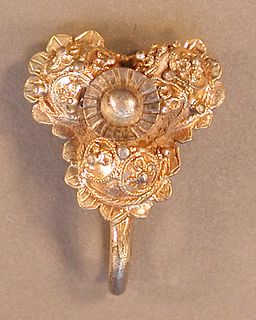 W
WA dress hook is a decorative clothing accessory of the medieval and Tudor periods used to fasten outer garments or to drape up skirts. Made of base metal or precious silver and silver-gilt, dress hooks are documented in wills and inventories, and surviving hooks have been identified in the archaeological record throughout England.
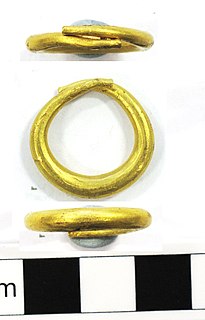 W
WAn earring is a piece of jewelry attached to the ear via a piercing in the earlobe or another external part of the ear. Earrings have been worn by people in different civilizations and historic periods, often with cultural significance.
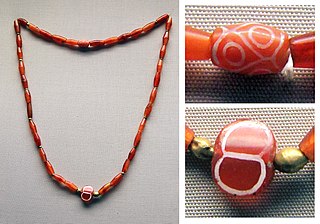 W
WEtched carnelian beads, or sometimes Bleached carnelian beads, are a type of ancient decorative beads made from carnelian with an etched design in white, which were probably manufactured by the Indus Valley civilization during the 3rd millennium BCE. They were made according to a technique of alkaline-etching developed by the Harappans, and vast quantities of these beads were found in the archaeological sites of the Indus Valley civilization. They are considered as an important marker of ancient trade between the Indus Valley, Mesopotamia and even Ancient Egypt, as these precious and unique manufactured items circulated in great numbers between these geographical areas during the 3rd millennium BCE, and have been found in numerous tomb deposits.
 W
WGold plating is a method of depositing a thin layer of gold onto the surface of another metal, most often copper or silver, by chemical or electrochemical plating. This article covers plating methods used in the modern electronics industry; for more traditional methods, often used for much larger objects, see gilding.
 W
WThe gold wreaths from Thrace are jewellery wreaths found in inner Thrace, which is within present day Bulgaria. The gold wreaths were found in the mounds and tombs of aristocrats at various locations in Thrace that have been dated to a period from the latter half of the fourth century and early part third century BC.
 W
WGranulation is a jewellery manufacturing technique whereby a surface is covered in spherules or granules of precious metal. The technique is thought to have its origins in Sumer about 5,000 years ago. This technique then spread to southern Europe during the orientalizing period, also through the role of Phoenicians, who had founded colonies in Sardinia, Sicily and Spain, or Near Eastern craftsmen.
 W
WHandmade jewelry is jewelry which has been assembled and formed by hand rather than through the use of machines.
 W
WHardstone carving is a general term in art history and archaeology for the artistic carving of predominantly semi-precious stones, such as jade, rock crystal, agate, onyx, jasper, serpentinite, or carnelian, and for an object made in this way. Normally the objects are small, and the category overlaps with both jewellery and sculpture. Hardstone carving is sometimes referred to by the Italian term pietre dure; however, pietra dura is the common term used for stone inlay work, which causes some confusion.
 W
WThe COVID-19 pandemic affects the global fashion industry as governments close down manufacturing plants, and through store closures, and event cancellations to slow the spread of the virus. The coronavirus pandemic has had a major impact on fashion brands worldwide. At the same time, the fashion industry faces challenges in consumer demand. New opportunities are also presenting themselves as fashion brands shift to making fashionable coronavirus face masks.
 W
WJewellery design is the art or profession of designing and creating jewellery. This is one of civilization's earliest forms of decoration, dating back at least 7,000 years to the oldest known human societies in Mesopotamia and Egypt. The art has taken many forms throughout the centuries, from the simple beadwork of ancient times to the sophisticated metalworking and gem cutting known in the modern day.
 W
WA jewellery store is a retail business establishment, that specializes in selling jewellery and watches. Jewellery stores provide many services such as repairs, remodeling, restoring, designing and manufacturing pieces.
 W
WDiana, Princess of Wales, was the first wife of Charles, Prince of Wales, and the mother of Prince William and Prince Harry. She owned a collection of jewels, both as a member of the British royal family and as a private individual. These were separate from the coronation and state regalia of the Crown Jewels. Most of her jewels were either presents from foreign royalty, on loan from Elizabeth II, wedding presents, purchased by Diana herself, or heirlooms belonging to the Spencer family.
 W
WKazaziye,, is a Turkish jewelry making technique. Kazaziye is a historical technique from the Caucasus. Kazaziye is a local art from the northern Turkish city Trabzon. Kazaziye made by hand with only 1000 carat silver or 24 carat gold. The exact history of Kazaz is not well-known, however, it is said that this art was born in Mesopotamia area by Lydians in 2800 BC and later spread north to Anatolia.
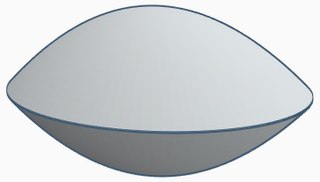 W
WLentoid is a geometric shape of a three-dimensional body, best described as a circle viewed from one direction and a convex lens viewed from every orthogonal direction. It has no strict mathematical definition, but may be described as the volume enclosed within overlapping paraboloids.
 W
WLive insect jewelry refers to jewelry made from living creatures – usually bejeweled oversized insects – which is worn as a fashion accessory. The use of insects as live jewelry has existed for many centuries, with the Egyptians believed to have been the first to have worn insects as jewelry. Ancient Egyptian soldiers commonly wore scarab beetles into battle as the beetles were considered to have supernatural powers of protection against enemies.
 W
WA living brooch, also known as a ma'kech, makech, and maquech, is a brooch made from a living beetle of the genus Zopherus, particularly the species Zopherus chilensis. The brooches are decorated with paste gemstones, bric-à-brac, and imitation gold, and are tethered to a woman's blouse by a small chain. Such brooches have traditionally been made in the Yucatan Peninsula of Mexico as objects of personal adornment. They do not move quickly, are very hardy, and are capable of living for over a month without food or water.
 W
WA lock ring, also spelled lock-ring, is a late Bronze Age penannular hair ornament. Typically made in gold, the intricate, decorative jewellery is recognized for its highly skilled workmanship. The name is derived from its suggested use as a hair fastener. Lock rings most likely originated in Ireland in the mid-eighth century B.C. They continued to be manufactured in Ireland, primarily in the River Shannon area into the seventh century B.C. Lock rings from the late Bronze Age have also been found in Great Britain and France.
 W
WThe Marcos jewels generally refers to the jewelry collection of the Marcos family – most famously that of former First Lady Imelda Marcos. However, it also specifically refers to three collections of jewelry which were recovered by the Presidential Commission on Good Government (PCGG) in 1986, which the Philippine Supreme Court had ruled to be part of the Marcoses' unlawful wealth.
 W
WThe Middle Ages was a period that spanned approximately 1000 years and is normally restricted to Europe and the Byzantine Empire. The material remains we have from that time, including jewelry, can vary greatly depending on the place and time of their creation, especially as Christianity discouraged the burial of jewellery as grave goods, except for royalty and important clerics, who were often buried in their best clothes and wearing jewels. The main material used for jewellery design in antiquity and leading into the Middle Ages was gold. Many different techniques were used to create working surfaces and add decoration to those surfaces to produce the jewellery, including soldering, plating and gilding, repoussé, chasing, inlay, enamelling, filigree and granulation, stamping, striking and casting. Major stylistic phases include barbarian, Byzantine, Carolingian and Ottonian, Viking, and the Late Middle Ages, when Western European styles became relatively similar.
 W
WA minaudière is a women's fashion accessory, generally considered a jewelry piece, intended to substitute for an evening bag. A case with compartments, it allows storage for several items in a small space, such as a makeup compact, lipstick, watch, reading glasses, or keys.
 W
WNiello is a black mixture, usually of sulphur, copper, silver, and lead, used as an inlay on engraved or etched metal, especially silver. It is added as a powder or paste, then fired until it melts or at least softens, and flows or is pushed into the engraved lines in the metal. It hardens and blackens when cool, and the niello on the flat surface is polished off to show the filled lines in black, contrasting with the polished metal around it. It may also be used with other metalworking techniques to cover larger areas, as seen in the sky in the diptych illustrated here. The metal where niello is to be placed is often roughened to provide a key. In many cases, especially in objects that have been buried underground, where the niello is now lost, the roughened surface indicates that it was once there.
 W
WJewellery making in the Pacific started later than in other areas, due to relatively recent human settlement. Early Polynesian jewellery, which was made of bone, wood and other natural materials, has not survived. The precise start of island jewellery-making is difficult to pinpoint, due to many of the island nations' founders migrating there from other areas, such as Tahiti.
 W
WA parure is a set of various items of matching jewelry, which rose to popularity early 19th-century Europe.
 W
WSchatzkammer, a German word which means "treasury" or "treasure chamber", is a term sometimes used in English for the collection of treasures, especially objets d’art in precious metals and jewels, of a ruler or other collector which are kept in a secure room and often found in the basement of a palace or castle. It also often included the wider types of object typical of the Renaissance cabinet of curiosities. A very small but evocative Renaissance room in a tower at Lacock Abbey was designed for keeping and viewing the treasures of the newly rich owner.
 W
WScottish jewellery is jewellery created in Scotland or in a style associated with Scotland, which today often takes the form of the Celtic style. It is often characterised by being inspired by nature, Scandinavian mythology, and Celtic knot patterns. Jewellery has a history in Scotland dating back to at least the Iron Age.
 W
WScythian art is the art associated with Scythian cultures, primarily decorative objects, such as jewellery, produced by the nomadic tribes of the area known as Scythia, which encompassed Central Asia, parts of Eastern Europe east of the Vistula River, and parts of South Asia, with the eastern edges of the region vaguely defined by ancient Greeks. The identities of the nomadic peoples of the steppes is often uncertain, and the term "Scythian" should often be taken loosely; the art of nomads much further east than the core Scythian territory exhibits close similarities as well as differences, and terms such as the "Scytho-Siberian world" are often used. Other Eurasian nomad peoples recognised by ancient writers, notably Herodotus, include the Massagetae, Sarmatians, and Saka, the last a name from Persian sources, while ancient Chinese sources speak of the Xiongnu or Hsiung-nu. Modern archaeologists recognise, among others, the Pazyryk, Tagar, and Aldy-Bel cultures, with the furthest east of all, the later Ordos culture a little west of Beijing. The art of these peoples is collectively known as steppes art.
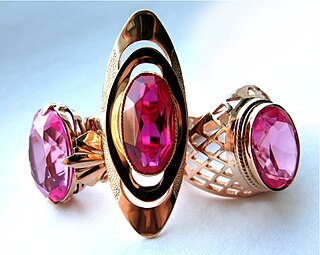 W
WSoviet jewelry is primarily gold, silver, platinum and palladium jewelry produced in The Union of Soviet Socialist Republics (USSR) between 1922 and 1991.
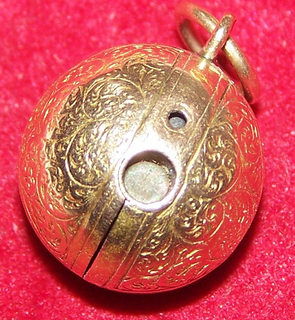 W
WStanhopes or Stanho-scopes are optical devices that enable the viewing of microphotographs without using a microscope. They were invented by René Dagron in 1857. Dagron bypassed the need for an expensive microscope to view the microscopic photographs by attaching the microphotograph at the end of a modified Stanhope lens. He called the devices bijoux photo-microscopiques or microscopic photo-jewelry. In 1862, Dagron displayed the devices at the Exhibition in London, where he got an "Honourable Mention" and presented them to Queen Victoria. In 1864 Dagron became famous when he produced a stanhope optical viewer which enabled the viewing of a microphotograph 1 square millimetre (0.0016 sq in),, that included the portraits of 450 people.
 W
WSterling silver is an alloy of silver containing 92.5% by weight of silver and 7.5% by weight of other metals, usually copper. The sterling silver standard has a minimum millesimal fineness of 925.
 W
WSuffrage jewellery refers to jewellery worn by suffragists, including suffragettes, in the years immediately preceding the First World War, ranging from the homemade to the mass-produced to fine, one-off Arts and Crafts pieces. Its primary purpose was to demonstrate its wearer's allegiance to the cause of women's suffrage in the UK. Jewellery was a key mechanism used by British suffragists to identify themselves.
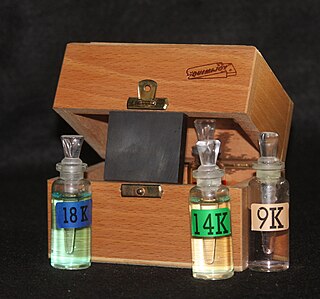 W
WA touchstone is a small tablet of dark stone such as slate or lydite, used for assaying precious metal alloys. It has a finely grained surface on which soft metals leave a visible trace.
 W
WTurkmen jewelry is a type of jewelry originating among the various Turkmen cultures of Western and Central Asia. The jewelry was crafted both for cosmetic and spiritual reasons, and the amount of jewelry an individual adorned themselves with was equated to the person's rank in society.
 W
WA watch strap, watch band, watch bracelet or watch belt is a bracelet that straps a wrist watch onto the wrist. Watch straps may be made of leather, plastic, rubber, cloth, or metal, sometimes in combination. It can be regarded as a fashion item, serving both a utilitarian and decorative function. Some metal watch straps may be plated with, or even in rare cases made of, precious metals.